Bob Hoover facts for kids
Quick facts for kids
Bob Hoover
|
|
|---|---|
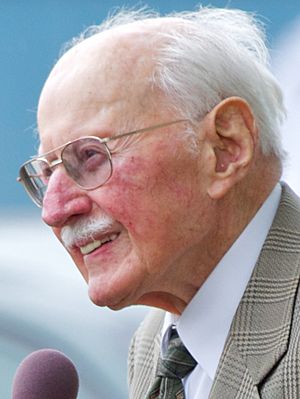
Hoover in 2011
|
|
| Birth name | Robert Anderson Hoover |
| Born | January 24, 1922 Nashville, Tennessee, U.S. |
| Died | October 25, 2016 (aged 94) Los Angeles, California, U.S. |
| Allegiance | |
| Service/ |
|
| Years of service | 1940–1950 |
| Rank | |
| Unit | 52nd Fighter Group Flight Evaluation Group |
| Battles/wars | World War II Korean War |
| Awards | Distinguished Flying Cross Soldier's Medal for Valor Air Medal with Clusters Purple Heart Croix de guerre |
| Spouse(s) |
Colleen Hoover
(m. 1948; |
| Other work | Test pilot, flight instructor and air show pilot (1948–1999) |
Robert Anderson Hoover (January 24, 1922 – October 25, 2016) was an amazing American pilot. He was a fighter pilot in wars, a test pilot who tried out new planes, and a flight instructor who taught others to fly. He was also a record-setting air show performer.
Hoover flew Spitfires for the U.S. Army Air Forces during World War II. In 1944, he was shot down near France. He spent over a year in a German POW camp (a prison camp for soldiers). He later escaped and flew to safety in a captured enemy plane!
After the war, he became a test pilot. He even flew alongside Chuck Yeager when Yeager broke the sound barrier in 1947. Hoover also taught pilots during the Korean War. He is most famous for his air show performances, which he did for almost 50 years until 1999. People called him the "pilot's pilot" because he was so skilled. Many say he was one of the greatest pilots ever.
He received many awards, including the Distinguished Flying Cross. He was also added to the National Aviation Hall of Fame in 1988. In 2013, Flying magazine called him one of the top 10 aviation heroes.
A Pilot's Journey
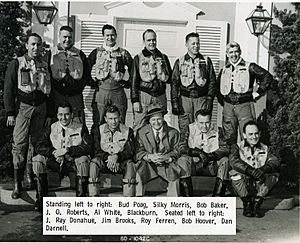
Bob Hoover learned to fly at Berry Field in Nashville, Tennessee. He worked at a grocery store to pay for his lessons. He then joined the Tennessee National Guard and trained to become a pilot for the United States Army.
During World War II, Hoover was sent to Casablanca. His first job was testing planes that were ready for battle. Later, he joined the 52d Fighter Group in Sicily, flying Spitfire planes. On February 9, 1944, during his 59th mission, his Spitfire was shot down by a German pilot. He was captured and spent 16 months in a German prisoner-of-war camp called Stalag Luft 1.
One night, there was a big fight in the camp. Hoover used this chance to climb the fence and escape. Two other prisoners joined him. They found a German farmhouse where a kind woman gave them food. Hoover left a note for her, asking the American army to treat her well. The woman also gave them a handgun.
The men then found bicycles and rode until they saw an empty airfield. Hoover, being a pilot, checked the planes. He found a Focke-Wulf Fw 190 reconnaissance plane that was damaged but had a full fuel tank. A German mechanic surprised them, but Hoover quickly pointed the gun at him and told him to start the plane's engine. Since the plane only had room for one person, Hoover made a deal: he would fly the plane, and the other two would keep the gun to help their escape. He didn't even use the runway; he just sped across a field and took off!
Hoover had no parachute and was flying an enemy plane toward Allied lines. He knew he could be shot down by American or British fighters. He didn't even know for sure if he had reached Allied land. He just looked for the windmills of Holland and planned to land when he saw them. After flying across The Netherlands, he finally spotted windmills and landed in a field. Angry Dutch farmers, thinking he was German, surrounded him with pitchforks! Luckily, a British supply truck came by, and Hoover was able to explain who he was.
After the war, Hoover became a flight-test pilot in Ohio. There, he met and became friends with Chuck Yeager. When Yeager needed a backup pilot for the first supersonic flight in the Bell X-1, he chose Hoover. Hoover flew a Lockheed P-80 Shooting Star alongside Yeager during that historic flight. He even flew chase for the 50th anniversary of the Mach 1 flight in a General Dynamics F-16 Fighting Falcon.
In 1948, Hoover left the Air Force for civilian jobs. He worked as a test pilot for North American Aviation. He went to Korea during the Korean War to teach pilots how to dive-bomb with the F-86 Sabre. He flew many bombing missions but was not allowed to join air-to-air combat.
During the 1950s, Hoover visited many air force bases. He showed pilots what different aircraft could do. He tested planes like the FJ-2 Fury, F-86 Sabre, and the North American F-100 Super Sabre.
In the early 1960s, Hoover started flying a P-51 Mustang at air shows. This plane, named "Ole Yeller," became very famous. He flew it and later an Aero Commander at hundreds of shows until he retired. In 1997, he sold "Ole Yeller" to his friend John Bagley. "Ole Yeller" still flies today!
Hoover set many flight records for speed and climbing. He knew many famous aviators, including Orville Wright, Charles Lindbergh, Jimmy Doolittle, Chuck Yeager, and Neil Armstrong.
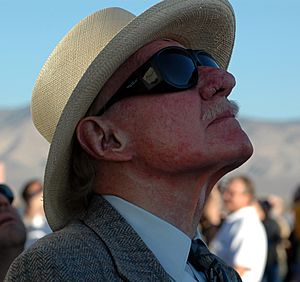
Hoover was most famous for his air show career. He was hired to show off the Shrike Commander, a business plane that looked a bit slow. But Hoover showed everyone how strong it was! He would do loops and rolls, things people didn't expect from a business plane. For his grand finale, he would turn off both engines and do a loop and a special slow roll. He would then land on one tire, then the other. After leaving the runway, he would restart the engines to taxi. Sometimes, he would even land directly on the parking ramp and coast all the way to his spot without restarting the engines!
He was also known for a cool trick: pouring a cup of tea while doing a barrel roll!
End of a Legendary Career
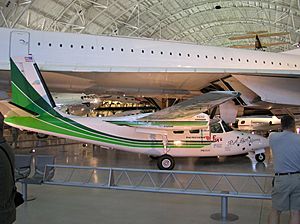
Bob Hoover's air show career ended in 1999. Before that, he had some problems with the Federal Aviation Administration (FAA). They took away his medical certificate, which pilots need to fly. This happened after he had serious engine trouble in a plane off the coast of California. He managed to land safely, but the FAA was concerned.
Hoover later got a pilot license and medical certificate from Australia. His U.S. medical certificate was restored, and he flew for several more years. At 77, he still felt he could fly, but he couldn't get insurance for air shows. It became too expensive. His last air show was on November 13, 1999. His last flight in his famous Shrike Commander was on October 10, 2003. He flew it from Florida to the National Air and Space Museum in Washington, D.C., where it is now on display.
In 2007, Hoover was added to the International Air & Space Hall of Fame.
Saying Goodbye
Hoover passed away on October 25, 2016, at his home in Los Angeles. He was 94 years old.
A special memorial service was held for him on November 18, 2016, at the Van Nuys Airport in California. Many famous people attended, including actor Harrison Ford and pilot Sean D. Tucker. The event ended with a fly-over by several planes, including a North American Sabreliner (like one Hoover flew) and jets from the United States Air Force Thunderbirds and Royal Canadian Air Force Snowbirds aerobatic teams. The P-51 "Ole Yeller" also flew in a special "missing man formation" to honor him.
Awards and Recognition
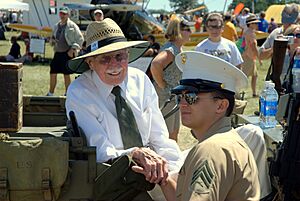
Many people considered Bob Hoover one of the most important figures in modern aerobatics (fancy flying). General Jimmy Doolittle called him "the greatest stick-and-rudder man who ever lived." In 2003, Air & Space/Smithsonian magazine named him the third greatest aviator in history.
During his career, Hoover received many military medals:
- The Distinguished Flying Cross
- The Soldier's Medal (for bravery not in combat)
- The Air Medal
- The Purple Heart
- The French Croix de Guerre
He was also made an honorary member of famous flight teams like the U.S. Navy Blue Angels and the U.S. Air Force Thunderbirds. He was added to the National Aviation Hall of Fame in 1988 and the Aerospace Walk of Honor in 1992.
In 2006, he received the Freedom of Flight Award, which was later renamed the Bob Hoover Freedom of Flight Award. In 2007, he received the Smithsonian's National Air and Space Museum Trophy. In 2010, the U.S. Air Force Test Pilot School gave him an honorary doctorate degree. In 2013, Flying magazine put him at number 10 on their list of "The 51 Heroes of Aviation."
In 2014, Hoover received the Wright Brothers Memorial Trophy, a very important award in aviation.
The AOPA R.A. "Bob" Hoover Trophy is named after him. It honors pilots who show great skill and passion, just like Hoover did. The Bob Hoover Academy, founded in 2017 by Sean Tucker, is also named after him. It helps young people learn about aviation.
In 2017, Hoover was chosen as the "Class Exemplar" for the United States Air Force Academy Class of 2020. This means he is a role model for the cadets.
Flying the Feathered Edge
A documentary film called Flying the Feathered Edge: The Bob Hoover Project was made in 2014. It tells the story of Bob Hoover's life and amazing flying career. The film was shown for the first time at the EAA AirVenture Oshkosh event in July 2014.
The movie features Harrison Ford and Sean Tucker. It also includes interviews with famous people like Neil Armstrong and Burt Rutan. The film covers Hoover's life from his first flying lessons to his time as a combat pilot, test pilot, and air show legend. Many people who saw the film were very moved by it.
The film won the "Soldiers and Sacrifice Award" at the Rhode Island International Film Festival. In 2015, it received the Combs Gates Award for helping to preserve aviation history.
The Hoover Nozzle
There's a special part on jet fuel pumps called the "Hoover nozzle." It has a flat shape. This nozzle cannot fit into the fuel tank of a plane that uses gasoline (not jet fuel) if that plane has a "Hoover ring" installed. This system helps stop people from accidentally putting the wrong type of fuel into a plane.
This system was named after Bob Hoover because of a serious accident he had. Both engines on his Shrike Commander failed during takeoff. Investigators found that the plane had been filled with jet fuel instead of aviation gasoline. There was just enough gasoline for the plane to taxi and take off, but then the jet fuel got into the engines and stopped them.
After Hoover recovered, he worked hard to promote this new nozzle system. Many aviation groups supported him. Now, this nozzle is required on jet fuel pumps in the United States by government rules.
See also
- List of aviators
- List of prisoners of war
- Society of Experimental Test Pilots


